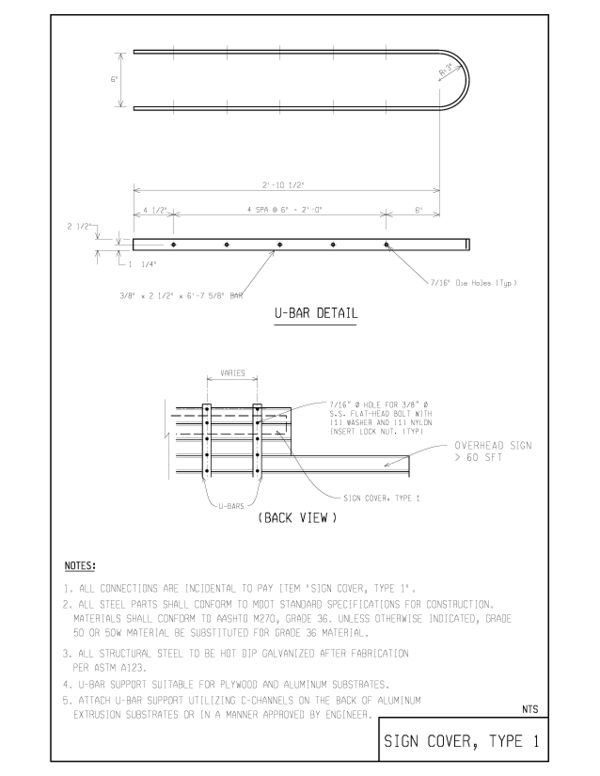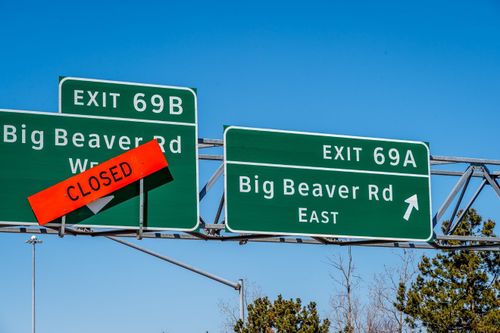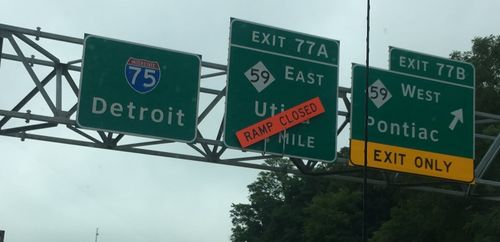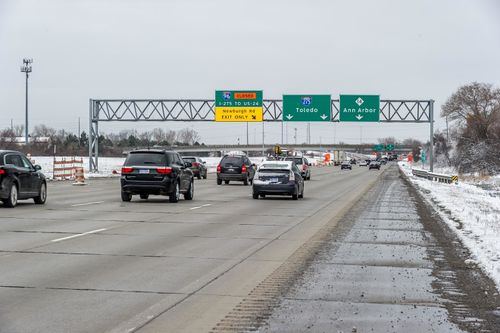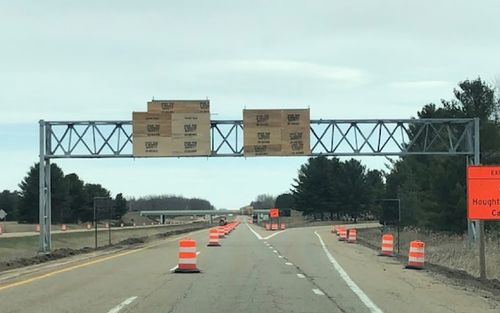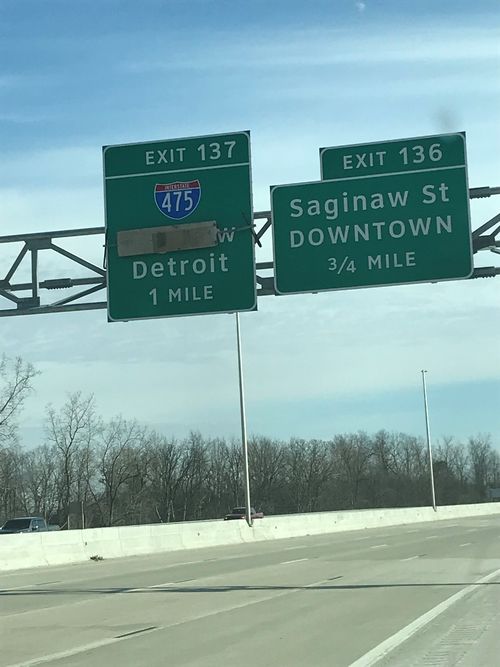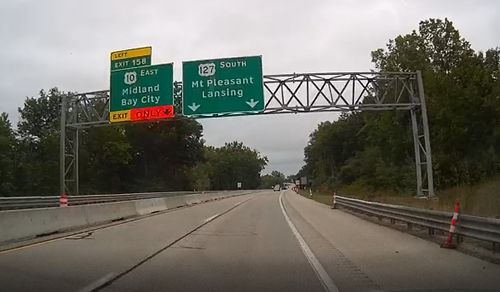Difference between revisions of "812 - Temporary Traffic Control for Construction Zone Operations"
m |
(Moved Measurement and Payment to bottom per Jason Clark) |
||
| (10 intermediate revisions by 6 users not shown) | |||
| Line 7: | Line 7: | ||
| − | ==GENERAL== | + | ==[[#GENERAL|GENERAL]]== |
| + | |||
| + | <span style="color: red"> -Update in Progress- </span> | ||
| + | |||
| + | ===[[#Freeway Work Zone Design Guidance|Freeway Work Zone Design Guidance]]=== | ||
| + | |||
| + | MDOT has established the following guidance on lane and shoulder widths when designing a | ||
| + | 3R/4R freeway work zone. Any alterations in the MOT during construction must take this into consideration along with consultation with Design and Traffic & Safety staff, prior to modification of the work zone design. | ||
| + | |||
| + | ::'''http://www.michigan.gov/documents/mdot/MDOT_IM14-10_475340_7.pdf''' | ||
| + | |||
| + | 3R/4R freeway Projects should have a minimum 11 foot lane, and any shoulder next to an open ditch should be at least 2 feet paved with 1 foot aggregate to the hinge point. If the open ditch shoulder width is equal to or less than the above dimensions, delineation devices as detailed in SOA 2013-001 Work Zone Safety Tools for Narrow Shoulders must be utilized. | ||
| + | |||
| + | In addition, a 1 foot minimum, 2 foot optimal shy distance from the edge line to the temporary traffic control device should be maintained. | ||
| + | |||
| + | |||
| + | {{top}} | ||
| + | |||
| + | ==[[#MATERIALS|MATERIALS]]== | ||
<span style="color: red"> -Reserved- </span> | <span style="color: red"> -Reserved- </span> | ||
| Line 13: | Line 31: | ||
{{top}} | {{top}} | ||
| − | == | + | ==[[#CONSTRUCTION|CONSTRUCTION]]== |
| + | |||
| + | ===[[#Solar Board Inspection Checklist|Solar Board Inspection Checklist]]=== | ||
| + | [http://mdotjboss.state.mi.us/webforms/GetDocument.htm?fileName=1013S.pdf Form 1013S], Inspectors Checklist for Solar Boards, may be used when inspecting Lighted Arrow, Type B and C arrow boards on construction projects. | ||
| + | |||
| + | The requirements for Lighted Arrow, Type B and C are described in Subsection 922.06 of the Standard Specifications for Construction. | ||
| + | |||
| + | If the form is utilized, inspectors need to verify all the information listed on Form [http://mdotjboss.state.mi.us/webforms/GetDocument.htm?fileName=1013S.pdf 1013S] and attach the form to the respective Inspectors Daily Report. | ||
| + | |||
| + | The form is available on MDOT’s form webpage. | ||
| + | |||
| + | {{Top}} | ||
| + | |||
| + | ===[[#Traffic Control During Special Marking Construction|Traffic Control During Special Marking Construction]]=== | ||
| + | These procedures apply to annual pavement marking contracts and acceptable methods of traffic control during special pavement marking removal and installation at intersections. | ||
| + | |||
| + | The State/Industry Construction Zone Review Team and Michigan State Police determined that working outside of the marked traffic lane closure during a traffic signal’s red indication is an acceptable work method, provided the following: | ||
| + | |||
| + | #Construction is considered short duration, as defined by the current edition of the Michigan Manual on Uniform Traffic Control Devices, Section 6G.02.[https://mdotcf.state.mi.us/public/tands/Details_Web/mmutcdpart6_2013%20(2).pdf MMUTCD.pdf] | ||
| + | #The contractor does not impede the flow of traffic beyond the existing traffic controls. | ||
| + | #The contractor works within the confines of the red indication only, is back in the closure or on the curb, and outside of the traveled way when the traffic signal changes to a green indication. | ||
| + | |||
| + | The use of hand signals is not permitted as a secondary measure of temporary traffic control when working outside of the established closure. The contractors are subject to the same rules and regulations as all other pedestrians when outside the closure during a red traffic signal indication. | ||
| + | |||
| + | If the contractor is found working in the open lane on a green traffic signal indication, the allowance of working in the open lane on a red traffic signal indication should be discontinued. | ||
| + | |||
| + | Construction staff should use the Special Provision for Maintaining Traffic to prohibit working during a red traffic signal indication for a particular location, locations, or corridors. Region and TSC wide restrictions that prohibit working on a red indication are not recommended. | ||
| + | |||
| + | {{Top}} | ||
| + | |||
| + | |||
| + | ==[[#OVERHEAD SIGN COVERS|OVERHEAD SIGN COVERS]]== | ||
| + | |||
| + | In accordance with Standard Specifications for Construction Section 812.03.D.2, Sign covers are to be installed on Type I signs and require the submittal of shop drawings by the Contractor. Sign covers should obscure conflicting information and provide guidance to motorists without the use of fastening devices bearing directly on the sheeting. Two inches of air space shall be required between the cover and the sign face for overhead signs. A lightweight material must be approved for use as a cover. Any permanent sign with a cover applied directly to the sign substrate without 2” of air space shall be replaced at no cost to the department. | ||
| + | |||
| + | An approved sign cover detail for [//{{SERVERNAME}}/images_construction/8/8d/SignCover_Type_1.pdf Type 1 Signs] is pictured below. Examples of best practices and inadvisable practices can be seen in the photographs below. | ||
| + | |||
| + | [[File:SignCover Type 1.jpg|center|600px|link=//{{SERVERNAME}}/images_construction/8/8d/SignCover_Type_1.pdf]] | ||
| + | |||
| + | {{top}} | ||
| + | |||
| + | ===[[#Examples of Best Practice Sign Covers|Examples of Best Practice Sign Covers]]=== | ||
| + | |||
| + | Orange sign cover stands out against permanent sign. It is clear the exit is closed and evident which exit is open as enough identifying information is left intact. | ||
| + | |||
| + | ::[[File:Best Practice Sign Covers - 1.jpg|left|500px]] | ||
| + | |||
| + | |||
| + | |||
| + | |||
| + | |||
| + | |||
| + | |||
| + | |||
| + | |||
| + | |||
| + | |||
| + | |||
| + | |||
| + | |||
| + | |||
| + | |||
| + | |||
| + | |||
| + | |||
| + | |||
| + | |||
| + | |||
| + | |||
| + | |||
| + | |||
| + | |||
| + | |||
| + | |||
| + | |||
| + | Orange sign cover stands out against permanent sign. It is clear which exit is closed and evident which exit is open as enough identifying information is left intact. | ||
| + | |||
| + | ::[[File:Best Practice Sign Covers - 2.jpg|left|500px]] | ||
| + | |||
| + | |||
| + | |||
| + | |||
| + | |||
| + | |||
| + | |||
| + | |||
| + | |||
| + | |||
| + | |||
| + | |||
| + | |||
| + | |||
| + | |||
| + | |||
| + | |||
| + | |||
| + | |||
| + | |||
| + | |||
| + | |||
| + | Profile view of u-bar attached to extruded aluminum sign. | ||
| + | |||
| + | ::[[File:Best Practice Sign Covers - 3.jpg|left|500px]] | ||
| + | |||
| + | |||
| + | |||
| + | |||
| + | |||
| + | |||
| + | |||
| + | |||
| + | |||
| + | |||
| + | |||
| + | |||
| + | |||
| + | |||
| + | |||
| + | |||
| + | |||
| + | |||
| + | |||
| + | |||
| + | |||
| + | |||
| + | |||
| + | |||
| + | |||
| + | |||
| + | |||
| + | |||
| + | |||
| + | |||
| + | |||
| − | |||
{{top}} | {{top}} | ||
| − | == | + | ===[[#Examples of Inadvisable Sign Covers|Examples of Inadvisable Sign Covers]]=== |
| + | |||
| + | Inadvisable because sign directly connected on reflective surface via adhesion. | ||
| + | |||
| + | ::[[File:Best Practice Sign Covers - 4.jpg|left|500px]] | ||
| + | |||
| + | |||
| + | |||
| + | |||
| + | |||
| + | |||
| + | |||
| + | |||
| + | |||
| + | |||
| + | |||
| + | |||
| + | |||
| + | |||
| + | |||
| + | |||
| + | |||
| + | |||
| + | |||
| + | |||
| + | |||
| + | |||
| + | |||
| + | |||
| + | |||
| + | |||
| + | |||
| + | |||
| + | |||
| + | Inadvisable because sign is completely covered, adding excess weight and posing a hazard to motorists, giving no directional information for motorists to know which routes are closed. | ||
| + | |||
| + | ::[[File:Best Practice Sign Covers - 5.jpg|left|500px]] | ||
| + | |||
| + | |||
| + | |||
| + | |||
| + | |||
| + | |||
| + | |||
| + | |||
| + | |||
| + | |||
| + | |||
| + | |||
| + | |||
| + | |||
| + | |||
| + | |||
| + | |||
| + | |||
| + | |||
| + | |||
| + | |||
| + | |||
| + | |||
| + | |||
| + | |||
| + | |||
| + | |||
| + | Inadvisable because gray/plywood sign cover does not stand out well against sign substrate and does not draw attention of the motorist. | ||
| + | |||
| + | ::[[File:Best Practice Sign Covers - 6.jpg|left|500px]] | ||
| + | |||
| + | |||
| + | |||
| + | |||
| + | |||
| + | |||
| + | |||
| + | |||
| + | |||
| + | |||
| + | |||
| + | |||
| + | |||
| + | |||
| + | |||
| + | |||
| + | |||
| + | |||
| + | |||
| + | |||
| + | |||
| + | |||
| + | |||
| + | |||
| + | |||
| + | |||
| + | |||
| + | |||
| + | |||
| + | |||
| + | |||
| + | |||
| + | |||
| + | |||
| + | |||
| + | |||
| + | |||
| + | |||
| + | |||
| + | |||
| + | |||
| + | |||
| + | |||
| + | |||
| + | |||
| + | |||
| + | |||
| + | |||
| + | |||
| + | |||
| + | |||
| + | |||
| + | |||
| + | |||
| + | Inadvisable because road geometry only has two lanes, but arrows overhead indicate three. | ||
| + | |||
| + | ::[[File:Best Practice Sign Covers - 7.jpg|left|500px]] | ||
| + | |||
| + | |||
| + | |||
| + | |||
| + | |||
| + | |||
| + | |||
| + | |||
| + | |||
| + | |||
| + | |||
| + | |||
| + | |||
| + | |||
| + | |||
| + | |||
| + | |||
| + | |||
| + | |||
| + | |||
| + | |||
| + | |||
| + | |||
| + | |||
| + | |||
| + | |||
| + | |||
| − | |||
{{top}} | {{top}} | ||
| − | ==MEASUREMENT AND PAYMENT== | + | ==[[#MEASUREMENT AND PAYMENT|MEASUREMENT AND PAYMENT]]== |
<span style="color: red"> -Reserved- </span> | <span style="color: red"> -Reserved- </span> | ||
{{top}} | {{top}} | ||
| + | |||
| + | [[Category:Construction Manual]] | ||
Revision as of 08:47, 3 August 2020
GENERAL
-Update in Progress-
Freeway Work Zone Design Guidance
MDOT has established the following guidance on lane and shoulder widths when designing a 3R/4R freeway work zone. Any alterations in the MOT during construction must take this into consideration along with consultation with Design and Traffic & Safety staff, prior to modification of the work zone design.
3R/4R freeway Projects should have a minimum 11 foot lane, and any shoulder next to an open ditch should be at least 2 feet paved with 1 foot aggregate to the hinge point. If the open ditch shoulder width is equal to or less than the above dimensions, delineation devices as detailed in SOA 2013-001 Work Zone Safety Tools for Narrow Shoulders must be utilized.
In addition, a 1 foot minimum, 2 foot optimal shy distance from the edge line to the temporary traffic control device should be maintained.
MATERIALS
-Reserved-
CONSTRUCTION
Solar Board Inspection Checklist
Form 1013S, Inspectors Checklist for Solar Boards, may be used when inspecting Lighted Arrow, Type B and C arrow boards on construction projects.
The requirements for Lighted Arrow, Type B and C are described in Subsection 922.06 of the Standard Specifications for Construction.
If the form is utilized, inspectors need to verify all the information listed on Form 1013S and attach the form to the respective Inspectors Daily Report.
The form is available on MDOT’s form webpage.
Traffic Control During Special Marking Construction
These procedures apply to annual pavement marking contracts and acceptable methods of traffic control during special pavement marking removal and installation at intersections.
The State/Industry Construction Zone Review Team and Michigan State Police determined that working outside of the marked traffic lane closure during a traffic signal’s red indication is an acceptable work method, provided the following:
- Construction is considered short duration, as defined by the current edition of the Michigan Manual on Uniform Traffic Control Devices, Section 6G.02.MMUTCD.pdf
- The contractor does not impede the flow of traffic beyond the existing traffic controls.
- The contractor works within the confines of the red indication only, is back in the closure or on the curb, and outside of the traveled way when the traffic signal changes to a green indication.
The use of hand signals is not permitted as a secondary measure of temporary traffic control when working outside of the established closure. The contractors are subject to the same rules and regulations as all other pedestrians when outside the closure during a red traffic signal indication.
If the contractor is found working in the open lane on a green traffic signal indication, the allowance of working in the open lane on a red traffic signal indication should be discontinued.
Construction staff should use the Special Provision for Maintaining Traffic to prohibit working during a red traffic signal indication for a particular location, locations, or corridors. Region and TSC wide restrictions that prohibit working on a red indication are not recommended.
OVERHEAD SIGN COVERS
In accordance with Standard Specifications for Construction Section 812.03.D.2, Sign covers are to be installed on Type I signs and require the submittal of shop drawings by the Contractor. Sign covers should obscure conflicting information and provide guidance to motorists without the use of fastening devices bearing directly on the sheeting. Two inches of air space shall be required between the cover and the sign face for overhead signs. A lightweight material must be approved for use as a cover. Any permanent sign with a cover applied directly to the sign substrate without 2” of air space shall be replaced at no cost to the department.
An approved sign cover detail for Type 1 Signs is pictured below. Examples of best practices and inadvisable practices can be seen in the photographs below.
Examples of Best Practice Sign Covers
Orange sign cover stands out against permanent sign. It is clear the exit is closed and evident which exit is open as enough identifying information is left intact.
Orange sign cover stands out against permanent sign. It is clear which exit is closed and evident which exit is open as enough identifying information is left intact.
Profile view of u-bar attached to extruded aluminum sign.
Examples of Inadvisable Sign Covers
Inadvisable because sign directly connected on reflective surface via adhesion.
Inadvisable because sign is completely covered, adding excess weight and posing a hazard to motorists, giving no directional information for motorists to know which routes are closed.
Inadvisable because gray/plywood sign cover does not stand out well against sign substrate and does not draw attention of the motorist.
Inadvisable because road geometry only has two lanes, but arrows overhead indicate three.
MEASUREMENT AND PAYMENT
-Reserved-
